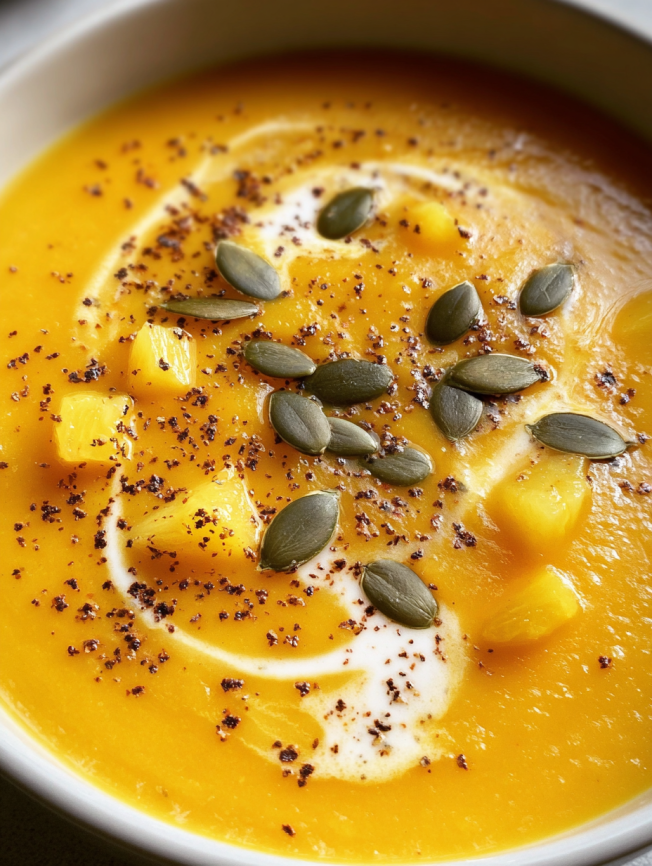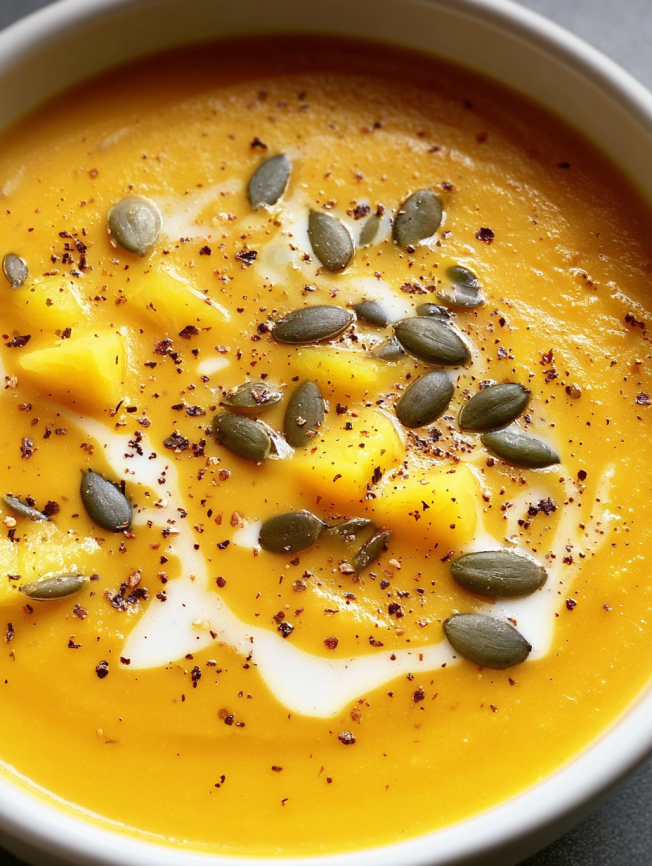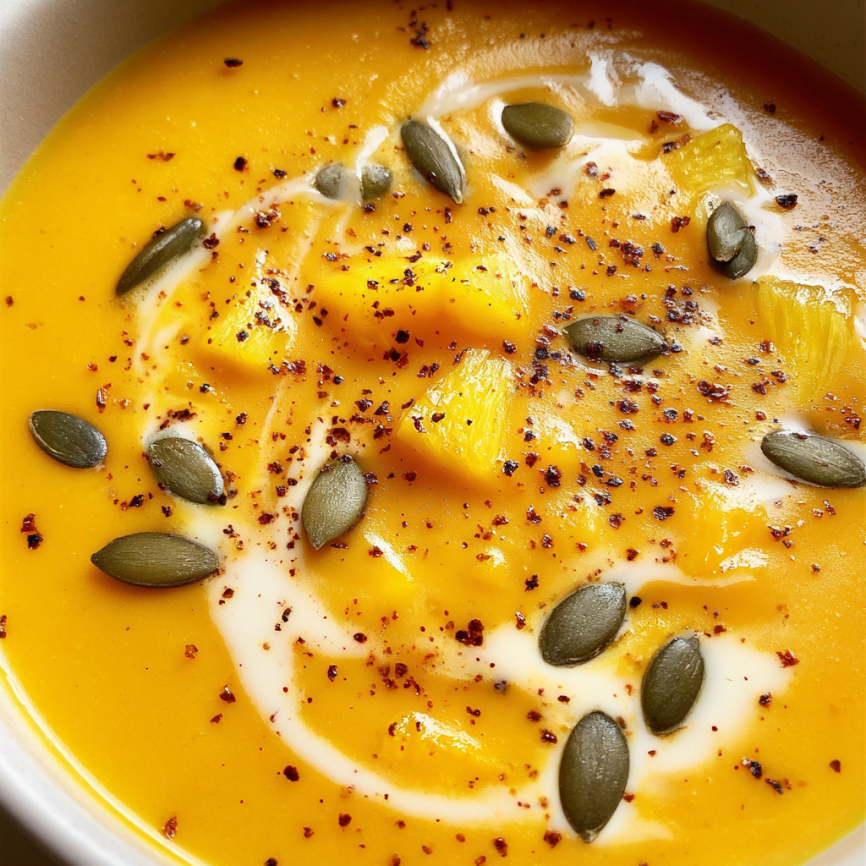A Cozy Kitchen Memory That Changed Everything
Last October, my lactose-intolerant sister visited for the first time since her diagnosis. She’d always loved my traditional butternut squash soup, made with heavy cream and butter, but now it was off-limits. Determined not to let dietary restrictions dim our cherished autumn tradition, I spent that crisp morning experimenting in the kitchen. After roasting the squash until caramelized and discovering the magic of full-fat coconut milk, I created something even better than the original. When she took that first spoonful and her eyes lit up with pure joy, I knew this dairy-free version would become our new family standard. Now, even my dairy-loving husband requests this version over the old recipe!
Why This Soup Will Become Your Go-To Fall Recipe
Naturally Creamy Without Any Dairy
The secret lies in the roasted butternut squash itself, which develops natural sweetness and creaminess when properly caramelized. Combined with rich coconut milk, the texture rivals any cream-based soup while being completely plant-based and easier to digest.
Nutrient-Dense Comfort Food
Unlike heavy cream-based soups that can leave you feeling sluggish, this version provides sustained energy through complex carbohydrates, fiber, and essential vitamins. The butternut squash alone delivers impressive amounts of vitamin A, vitamin C, and potassium.
Freezer-Friendly Convenience
This soup actually improves in flavor after freezing, making it perfect for meal prep. Additionally, it reheats beautifully, ensuring you always have a comforting meal ready during busy weeknights.
Universally Appealing
Whether you’re serving vegans, those with lactose intolerance, or simply health-conscious diners, this soup satisfies everyone at the table without anyone feeling like they’re missing out.
Essential Ingredients
For the Roasted Base
- 1 medium butternut squash (about 2-3 pounds), peeled, seeded, and cubed
- 1 tablespoon olive oil, divided
- 1 yellow onion, diced
- 3 cloves garlic, minced
For the Aromatic Foundation
- 2 carrots, chopped
- 2 stalks celery, chopped
- 1 apple, peeled, cored, and chopped (Honeycrisp or Gala work beautifully)
- 4 cups high-quality vegetable broth
For the Warming Spices
- 1 teaspoon ground cinnamon
- 1/2 teaspoon ground nutmeg
- Salt and freshly ground black pepper to taste
- 1/2 cup canned coconut milk (full-fat for optimal creaminess)
Optional Garnishes
- Toasted pumpkin seeds
- Fresh herbs (sage, thyme, or parsley)
- A drizzle of coconut cream
- A sprinkle of smoked paprika
Serving Suggestions
This recipe serves 6 generously and pairs beautifully with crusty sourdough bread, grain-free crackers, or a simple arugula salad dressed with lemon vinaigrette.
Step-by-Step Instructions
Roasting for Maximum Flavor
- Prepare for roasting: Preheat your oven to 400°F (200°C) and line a large baking sheet with parchment paper. This high heat will caramelize the squash edges, creating deeper flavor.
- Season the squash: Toss the butternut squash cubes with half the olive oil and a generous pinch of salt. Spread them in a single layer on the prepared baking sheet, ensuring they’re not overcrowded.
- Roast to perfection: Bake for 25-30 minutes, until the edges are caramelized and the flesh is fork-tender. This roasting step is crucial for developing the soup’s complex sweetness.
Building the Flavor Base
- Sauté the aromatics: While the squash roasts, heat the remaining olive oil in a large, heavy-bottomed pot over medium heat. Add the diced onion and sauté for 3-4 minutes until it becomes translucent and fragrant.
- Add the vegetables: Incorporate the minced garlic, chopped carrots, and celery. Cook for another 5 minutes, stirring occasionally, until the vegetables begin to soften and release their natural sweetness.
Simmering and Blending
- Combine and simmer: Add the roasted butternut squash, chopped apple, vegetable broth, cinnamon, nutmeg, salt, and pepper to the pot. Bring the mixture to a rolling boil, then reduce heat to maintain a gentle simmer for 20 minutes.
- Blend to silky smoothness: Remove the pot from heat and let it cool slightly for safety. Using an immersion blender, purée the soup directly in the pot until completely smooth. Alternatively, carefully transfer the soup in batches to a high-speed blender.
- Add the finishing touch: Stir in the coconut milk until well incorporated. Taste and adjust seasonings as needed, adding more salt, pepper, or spices to your preference.
- Serve with style: Ladle into warmed bowls and garnish with your choice of toppings for an elegant presentation.

Creative Serving Ideas
Elegant Presentation
Serve in pre-warmed bowls with a artistic swirl of coconut cream and a sprinkle of toasted pumpkin seeds. Add a few fresh sage leaves for a restaurant-quality appearance that impresses guests.
Bread Bowl Brilliance
Hollow out small round sourdough loaves and serve the soup inside for a rustic, Instagram-worthy presentation that eliminates the need for extra dishes.
Delicious Recipe Variations
Spiced Autumn Version
Add a pinch of ground ginger, cardamom, and a dash of cayenne pepper for warming complexity. This variation pairs exceptionally well with Indian flatbreads or naan.
Apple-Forward Delight
Increase the apple to two medium fruits and add a splash of apple cider for enhanced fruit flavors. This version appeals especially to those who love sweet and savory combinations.
Protein-Packed Option
Stir in cooked white beans or chickpeas during the final few minutes of simmering for added protein and fiber. This transforms the soup into a more substantial meal.
Coconut-Forward Richness
Replace half the vegetable broth with light coconut milk for an ultra-creamy version that’s still dairy-free but incredibly indulgent.
Make-Ahead and Storage Tips
Advance Preparation
The soup can be made up to 3 days ahead and actually improves in flavor as it sits. Store in the refrigerator and reheat gently on the stovetop, adding a splash of broth if needed to restore the desired consistency.
Freezing Guidelines
This soup freezes beautifully for up to 6 months. Pour cooled soup into freezer-safe containers, leaving an inch of space for expansion. Thaw overnight in the refrigerator before reheating.
Reheating Best Practices
Reheat gently over medium-low heat, stirring occasionally to prevent sticking. The coconut milk may separate slightly, but whisking will restore the smooth texture.
Important Notes
Squash Selection Tips
Choose butternut squash that feels heavy for its size with hard, tan skin free of soft spots. The neck portion contains the most usable flesh, so look for squashes with longer necks relative to the bulbous bottom.
Coconut Milk Considerations
Full-fat coconut milk provides the richest texture, but light coconut milk works if you prefer a lighter soup. Avoid coconut milk beverages, which are too thin for this recipe.
Safety Reminders
Always let soup cool slightly before blending to prevent dangerous splattering. When using a regular blender, work in small batches and hold the lid securely with a kitchen towel.

Frequently Asked Questions
Can I use pre-cut butternut squash to save time? Absolutely! Pre-cut butternut squash from the grocery store works perfectly and saves significant prep time. Just ensure the pieces are relatively uniform in size for even roasting.
What can I substitute for the apple? Pears work beautifully as a substitute and provide similar sweetness. You can also use sweet potato for a different but equally delicious flavor profile, or omit the fruit entirely for a more savory soup.
How can I make this soup less sweet? Reduce or omit the apple, and add a splash of apple cider vinegar or lemon juice at the end to balance the natural sweetness of the squash. You can also increase the savory elements like garlic and herbs.
Is this soup suitable for those following a keto diet? While butternut squash is naturally higher in carbohydrates, you can make a lower-carb version by reducing the squash and adding cauliflower or turnips. However, it won’t be strictly keto-compliant.
What’s the best way to peel butternut squash safely? Use a sharp vegetable peeler or paring knife, working from top to bottom. For easier peeling, you can microwave the whole squash for 2-3 minutes to soften the skin slightly before peeling.
Can I make this soup in a slow cooker? Yes! After roasting the squash, combine all ingredients except the coconut milk in a slow cooker. Cook on low for 6-8 hours or high for 3-4 hours, then blend and stir in the coconut milk before serving.
How do I know when the vegetables are properly cooked? All vegetables should yield easily to a fork. The carrots and celery should be completely tender, and the squash should practically fall apart when stirred. Under-cooked vegetables will create a gritty texture in the final soup.
Can I use other types of winter squash? Definitely! Acorn squash, delicata squash, or kabocha squash all work wonderfully. Each will provide slightly different flavors and textures, but the basic technique remains the same.
Prep Time: 10 minutes | Cooking Time: 50 minutes | Total Time: 1 hour
Calories: 180 kcal | Servings: 6 servings

